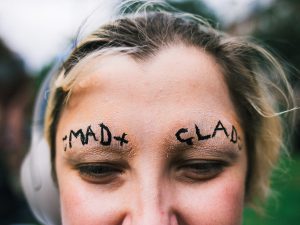Tamara Hart reflects on the meaning of posters and images at the recent Mad Pride event in London, organised by the Campaign for Psychiatric Abolition

Social movements are woven with textures – from wet placards and warm tears, to quilts and clenched fists. As I sit in a banner-making workshop for Mad Pride in London, I see support stitched into fabrics and inked onto pins. I feel a shared language, a fight to imagine worlds otherwise.
Mad Pride is an annual festival rooted in the experiences of psychiatric survivors. After almost a decade of silence, the festival re-emerged in London in 2022, organised by the Campaign for Psychiatric Abolition (CPA). The CPA is comprised of psych survivors who advocate against the violence of policing, prisons, and psychiatry, and the festival is rooted in abolitionist frameworks. Not only do their posters read ACAB (All Cops Are Bastards), but they also read APAB (All Psychs Are Bastards).
Many members of this community are students and people in their twenties and thirties who have been injured by psychiatry. Some were made to take medication with harmful side effects; others found themselves without family or homes during a crisis, or written off as hopeless after suicide attempts.
When I enter the festival, the first poster I see is painted in sparkling pink letters. It reads, BPD: Beautiful Princess Disorder. I smile – it’s disarming to see an anarchist slogan in glitter. This poster contests the diagnosis BPD (Borderline Personality Disorder) by turning its acronym sideways. It’s a way to queer medical knowledge, to kink its meaning. If you’re going to be reduced to a label or an illness, why not make it glamorous?
The poster also reflects the wicked humour that the Mad Pride movement uses to undermine psychiatric authority. Joking about power structures might not dismantle them, but it can refuse their conditions. As theorist Lisa Bhungalia has written, to laugh in the face of power is to say, ‘your power has no authority over me’. The banners, badges, and patches of this festival use quips to point out the absurd realities that Mad people must endure.
Mad Pride first began in 1993 in my hometown, Toronto. Originally named ‘Psychiatric Survivor Pride Day’, it was created by four psych survivors who saw the success of Pride marches in advocating for the rights of LGBTQ+ communities. In this sense, the festival is rooted in queer strategies of resistance. It is no wonder that it attracts many queer members internationally.
Laced with tough black nail varnish and flamboyant posters, it brings together comrades who fight for liberation on intersecting fronts. As many Mad Studies scholars point out, psychiatry and scientific racism share a common history. The scientific labelling of non-white bodies as inferior and deviant in Western medicine has historically led to their dismissal as mentally degenerate. This not only served to justify their slavery, but also de-politicised their resistance. Defined as Mad subjects, Black bodies were stripped not only of their dignity, but also of their rationality.
In many ways, this framework still prevails in our mental health systems. In the UK, Black people and ethnic minorities are more often detained under the Mental Health Act and given coercive physical treatments than their white counterparts. Rather than viewing their distress as valid reactions to oppressive social conditions, psychiatry polices their resistance. It is no coincidence, then, that the Mad Pride logo is reminiscent of abolitionist imagery: it shows a figure unshackling its chains.
While I attend the festival, my twin brother is in a psychiatric ward in Toronto. As carers, we learn to be social workers, medical professionals and crisis support teams, all-in-one. We are advised by psychiatrists to call the police at the height of extreme states. In this way, risk prevention for our loved ones is often achieved at the expense of their autonomy and dignity. This cycle coerces us into complying with the same systems that harm us.
We should not be forced into either colluding with police, or holding unbearable distress until it breaks us. We must imagine that long-term community care, safe housing, and financial support are possible. It is by imagining otherwise that we begin to mobilise. To pull apart the threads of existing systems and sew patchworks of reform.

At Mad Pride, I see familiar faces: the green-haired stallion just released from the hospital, the quiet printmaker skilfully crafting stencils, and other self-proclaimed ‘lunatics’ exchanging zines. This younger generation of psych survivors have experienced hostile systems that dismiss their agency, making them feel forgotten before they have really lived. It’s only natural that they hold posters with slogans such as:
Dehumanized
Mad at the system
Burn down psych
As I read these words, counterarguments stick to my tongue: What happens after we burn down psychiatry? How will our communities be housed and supported? With what funding and resources?
In some ways, the structural realities of these Mad statements are beside the point. Instead, they can be viewed as calls against current systems of power. As Lola Olufemi pens, ‘Against is not without conflict, it is not without pain, it is only brief respite before strategising begins’.
While older generations of the Mad movement work to build social housing and formal advocacy networks, often including psych workers in their initiatives, this younger group of Mad activists fight against existing mental health systems and all those who are complicit with them. This is their point of departure: a refusal of all that is, in order to imagine new structures.
Although this fails to take into account psych workers who are also survivors, and other complexities of mental health systems, this strategy allows them to foster grassroots knowledge, to gain energy and steam after initial encounters with harsh systems. It is a way to resist being broken down.
Though they may seem opposed, in my view, these intergenerational initiatives can work hand in hand. Their textures may be different, but their goals remain the same: to build fabrics of support outside of harmful institutions. To share survivor narratives, to educate and exchange resources, and to keep one another alive in the process. It is these forms of mutual aid that burn down current forms of psychiatry. It is when we laugh at the absurdity of medical systems that we undermine their power. It is when we find rest and respite that we begin to strategise.
As the festival comes to an end, I see my favourite poster, a little card with block magenta lettering: Mad and queer, spinning hope from fear. To me, these words are at the heart of Mad Pride. It is a movement that is queer in its methods, fierce in its vulnerabilities, and gracefully imperfect. It is warm wool spun from solidarity; a political act against what is; a knife that cuts with flare.
Tamara Hart (she/they) is a visual anthropologist based in London. Their research explores visual and material narratives within mental health structures, focusing on practices of peer support.
This is a sample article from the Autumn 2023 issue of Asylum Magazine (30.3). To read more, subscribe to Asylum Magazine.
